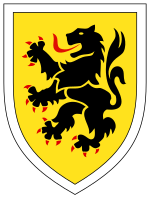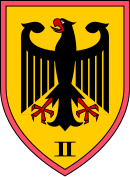Armored Brigade 28
 Association badge |
|
| active | April 1, 1975 to Sep. 30 1993 |
| Country |
|
| Armed forces |
|
| Armed forces |
|
| Type | Tank brigade |
| Insinuation |
|
| Staff seat | Dornstadt |
The Panzerbrigade 28 was a brigade of the Army of the Bundeswehr with headquarters in Dornstadt , which existed from 1975 to 1994. From 1964 to 1970 there was a 28th Panzer Grenadier Brigade based in Donauwörth . Both brigades were subordinate to the 10th Panzer Division . Their stationing area extended from the Swabian Alb to the Bavarian Danube Valley .
history
The "old" Panzer Grenadier Brigade 28 in Army Structure 2
The later 28th Panzer Brigade is not part of the traditional line of the "old" 28th Panzer Grenadier Brigade, which existed only briefly from 1964 to 1970. The "old" Panzer Grenadier Brigade 28 was set up in Donauwörth in 1964 . Parts of the "old" Panzer Grenadier Brigade 28 were used after their dissolution in 1970 to form the Heimatschutzkommando 18 in the territorial army. Homeland Security Command 18, with its headquarters in Neuburg an der Donau, was subordinate to Military District Command VI in Munich .
Army structure 3
Prehistory as a tank regiment in Army Structure 3
In 1971, a 200 tank regiment was formed from tank battalion 304 (tank battalion 284) of tank brigade 30 , analogous to the procedure for tank brigade 20 . The regiment also included the tank battalion 303, which was set up in Borken as tank battalion 281 in 1958. This moved to Münsingen in 1959 and to Dornstadt in 1962. From 1971 to 1975 the 303 tank battalion was integrated into the 200 tank regiment as 210 tank battalion. Between 1975 and 1981 it was renamed Panzerbataillon 281 and later Panzerbataillon 282.
As a brigade in the Army Structure 3
The "new" 28th Brigade was created in 1975 in Army Structure 3 as the 28th Panzer Brigade in Dornstadt from the 200th Panzer Regiment. Panzerbrigade 28 was subordinate to the 10th Panzer Division and initially tested army models of the upcoming Army Structure 4. With the brigade, Panzerbataillon 283 was also formed in 1976 from parts of Panzer Battalion 304, 1st / Panzer Battalion 283, 3rd / Panzer Battalion 283 and 4th / Tank battalion 220 reorganized. From 1974, the brigade also included the 281 Panzer Grenadier Battalion from Neuburg, which switched to the Brigade from the 29th Panzer Brigade, was reclassified to the 284 tank battalion in 1978 and switched to the 30th Panzer Brigade in 1978 . In 1974 the supply battalion 286 from Neuburg an der Donau switched to the brigade. In 1975 the 281 Panzer Grenadier Battalion was reorganized from parts of the 200 Panzer Regiment. In 1975 the supply company 280 and repair company 280 were formed. In 1976 the Panzerjägerkompanie 280 was formed in Dornstadt. In 1978 the tank training company driving simulator 201 and in 1979 the tank training center Combat Simulator 202 was subordinated. In 1979 the Panzer Pioneer Company 280 set up in Ingolstadt in 1975 switched to the brigade. Until 1977 the Panzerartilleriebataillon 285 was formed from parts of the Panzerartilleriebataillon 305 in Donauwörth and moved to Münsingen in 1976. The testing of Army Structure 4 was completed in 1977. In this context, Panzerbataillon 220 got its old number 284 back.
Army structure 4
When Army Structure 4 was taken over, Panzergrenadierbataillon 281 was renamed Panzergrenadierbataillon 282 in 1981. The brigade comprised around 2900 soldiers in the peace structure in the autumn of 1989 . The planned growth force in the case of defense was around 3300 men. For nursery which was convened by reservists and the mobilization of non-active units provided. At the end of Army Structure 4 in autumn 1989, the brigade was still part of the 10th Panzer Division and was roughly divided into the following troop units :
-
 Bar / Stabskompanie Panzerbrigade 28, Dornstadt
Bar / Stabskompanie Panzerbrigade 28, Dornstadt
-
 Panzerjägerkompanie 280, Dornstadt
Panzerjägerkompanie 280, Dornstadt -
 Panzerpionierkompanie 280, Ingolstadt
Panzerpionierkompanie 280, Ingolstadt
-
 Supply company 280, Dornstadt
Supply company 280, Dornstadt -
 Repair company 280, Dornstadt
Repair company 280, Dornstadt -
 Panzerbataillon 281 (partly active), Dornstadt
Panzerbataillon 281 (partly active), Dornstadt
-
 282 Panzer Grenadier Battalion, Dornstadt
282 Panzer Grenadier Battalion, Dornstadt -
 Tank battalion 283, Münsingen
Tank battalion 283, Münsingen
-
 Panzerbataillon 284, Dornstadt
Panzerbataillon 284, Dornstadt -
 285 Panzer Artillery Battalion, Münsingen
285 Panzer Artillery Battalion, Münsingen
-
Army structure 5 until disbandment
From 1992 to 1994 the brigade was disbanded. The brigade handed over the 285 Panzer Artillery Battalion in Münsingen to the 30th Panzer Brigade .
Commanders
The following officers led the brigades described with the number 28 or the Panzer Regiment 200 ( rank at handover). Usually, after some time, the commanders were promoted to brigadier general:
| No. | Surname | Beginning of the appointment | End of appointment |
|---|---|---|---|
| 9 | Colonel Karl Georg Sasse | October 1, 1992 | September 30, 1993 |
| 8th | Colonel Rudi Ehninger | April 1, 1990 | September 30, 1992 |
| 7th | Brigadier General Dietrich Rogler | April 1, 1983 | March 31, 1990 |
| 6th | Brigadier General Erich Schwemmle | April 1, 1978 | March 31, 1983 |
| 5 | Colonel Günter Baer | 1st October 1974 | March 31, 1978 |
| 4th | Colonel Franz-Joachim von Rodde | 1971 | 1974 |
| 3 | Colonel Carl Völkl | March 24, 1970 | 1971 |
| 2 | Colonel Reinhold Rehfeld | April 1, 1967 | March 23, 1970 |
| 1 | Colonel Ludwig von Köckritz | May 2, 1964 | March 31, 1967 |
Association badge
The blazon of the association badge for the uniform of the members of the 28th Panzer Brigade (and also of the former 28th Panzer Grenadier Brigade) read:
- Silver rimmed in gold a black rotbewehrter and rotgezungter lion .
The lion was the Swabian Staufer lion , which appeared similarly in the coat of arms of Baden-Württemberg . The association badges of the division and the subordinate brigades were identical except for the shelves . In the tradition of the Prussian color sequence , the association badge of the 28th Panzer Brigade was the “first” brigade of the division with a white border.
Since the badges of the division's brigades differed only slightly, the internal badge of the staff or the staff company pars pro toto was occasionally used as the brigade's "badge" instead . It showed a stylized battle tank , the number 28 , three stag poles and the black and silver coat of arms of the Hohenzollern family as in the large state coat of arms . The black shield matched the color of the armored troop's beret .
Remarks
- ↑ Shown are the internal association badges, for which a wearing permit was officially granted until around the mid-1980s. Inactive units (equipment units, partially active, cadre units) are shown in italics .
- ↑ "First" Brigade: Panzer Brigade 28 (= white board). "Second" Brigade: Panzer Brigade 29 (= red board). "Third" Brigade: Panzer Grenadier Brigade 30 (= yellow board).
literature
- Wolf Skornig, Panzerbrigade 28 (ed.): Open day: Sunday 7th July 1985 . Information leaflet for guests and soldiers. Panzer Brigade 28 Dornstadt Rommelkaserne. Mönch, Koblenz, Bonn 1985, DNB 971610754 (72 pages).
Web links
- Joachim Lenk: Rommel barracks / Lerchenfeld. Press office Joachim Lenk, accessed on February 29, 2020 .
Individual evidence
- ↑ a b Location database of the Bundeswehr in the Federal Republic of Germany as well as the training grounds used by the Bundeswehr abroad. In: Website of the Military History Research Office . Center for Military History and Social Sciences of the Bundeswehr , Military History Research Office , accessed on February 17, 2020 (For technical reasons, direct links to individual search queries or search results are not possible. Please use the “search form” to research information on the individual departments).
- ↑ a b c d O. W. Dragoner (Ed.): The Bundeswehr 1989 . Organization and equipment of the armed forces of the Federal Republic of Germany at the end of the Cold War. 4th edition. 2.1 - Army. Army Office. I. Corps. II Corps. III. Corps, February 2012 (167 p., Relektiven.com [PDF; 747 kB ; accessed on February 21, 2020] First edition: 2009, overview of the series at Relict.com).
- ^ Uwe Walter: The structures and associations of the German army . 1st edition. Part 1., I. Corps: (1956-1995). Edition AVRA, Berlin 2017, ISBN 978-3-946467-32-8 , pp. 104 (260 pp.).
- ^ Section MA 3 : BArch BH 9-28 / Panzerbrigade 28. In: Research application invenio . President of the Federal Archives , 2004, accessed on February 17, 2020 .
Coordinates: 48 ° 27 '8.7 " N , 9 ° 57' 38.2" E


